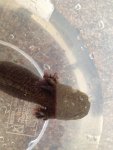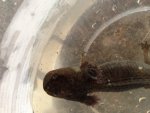Janni
New member
Hi All, this is going to be a long introduction to the current problem.
I recently bought 2 axolotls from a friend who was bored of them, about a month ago. They had been living on gravel substrate on a window sill. I am not exactly sure how old they are, friend had them for about a year. I made sure I read as much as possible to try to help them back to health. Over the month they have pooped out a lot of stones (it was over 30 in the first week), and the stones are fished out. They eat well and their gills are a lot bushier than before.
The current problem is the wild type one has white spots developing on its body. When we first got it, there was a patch on its face that my friend said had been there since being bought and hadn't changed. He still eats well and behaves exactly the same.
They currently live on fine sand substrate. The tank unfortunately couldn't be cycled before putting them in, but the parameters are monitored. The temperature is around 18-20 Celsius. The pH is about 8 (unsure how to get this down). Ammonia is 0, nitrite is high (I assume this is because the tank is still settling the nitrate cycle) and the nitrate is 20-25mg/L. We change the water every week about 30% with dechlorinated water and use a filter.
After reading this forum and axolotl.org and CC, I think the white spots are either fungus or due to heat stress (by appearance, I thought the tank temperature was ok for them?). The spots aren't fluffy. I've attached some pictures.
Basically I've performed one salt bath following instructions on the sticky and started fridging him.
Can someone let me know if this is the right plan or if there is something else I need to do?
Also should I be doing the same to the other leucistic, I can't see any patches on him but its difficult with his colour.
I recently bought 2 axolotls from a friend who was bored of them, about a month ago. They had been living on gravel substrate on a window sill. I am not exactly sure how old they are, friend had them for about a year. I made sure I read as much as possible to try to help them back to health. Over the month they have pooped out a lot of stones (it was over 30 in the first week), and the stones are fished out. They eat well and their gills are a lot bushier than before.
The current problem is the wild type one has white spots developing on its body. When we first got it, there was a patch on its face that my friend said had been there since being bought and hadn't changed. He still eats well and behaves exactly the same.
They currently live on fine sand substrate. The tank unfortunately couldn't be cycled before putting them in, but the parameters are monitored. The temperature is around 18-20 Celsius. The pH is about 8 (unsure how to get this down). Ammonia is 0, nitrite is high (I assume this is because the tank is still settling the nitrate cycle) and the nitrate is 20-25mg/L. We change the water every week about 30% with dechlorinated water and use a filter.
After reading this forum and axolotl.org and CC, I think the white spots are either fungus or due to heat stress (by appearance, I thought the tank temperature was ok for them?). The spots aren't fluffy. I've attached some pictures.
Basically I've performed one salt bath following instructions on the sticky and started fridging him.
Can someone let me know if this is the right plan or if there is something else I need to do?
Also should I be doing the same to the other leucistic, I can't see any patches on him but its difficult with his colour.
Attachments
Last edited:


